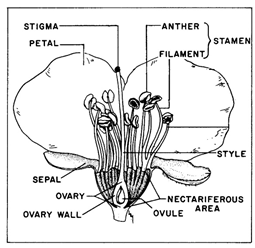Adapted from the article “Honey Bee Safety During Prune Bloom” by Franz Niederholzer, UCCE Farm Advisor, Colusa/Sutter/Yuba Counties and Emily J. Symmes, UCCE Area IPM Advisor, Sacramento Valley in the February 2015 Sacramento Valley Prune News
Prune growers grow prunes. Beekeepers keep bees. Why should prune growers be concerned about long-term bee hive health? Because strong honey bee activity in prune orchards is key to producing a large, profitable prune crop. Prunes are self-fertile, but require bees (or other insects) to move pollen within flowers to set a crop. Prune growers should do all they can to maintain a strong, healthy bee supply by providing a safe working environment for bees in their orchards.
The single most important thing growers can do to maintain bee health in their orchards is KEEP THE POLLEN CLEAN. Pollen is collected by foraging bees and taken to the hive as a source of proteins, fats, vitamins and other nutrients for the brood (the young, growing bees). Pollen directly sprayed with pesticides can damage hive health when fed to the growing brood. Pollen is released by some of the anthers in each flower in the morning as

Figure 1. Cross-section of a prune flower, showing different flower parts.
relative humidity drops and the orchard warms (see Figure 1). Bees usually strips all pollen available that day from the flowers by early to mid-afternoon. More anthers will “pop” each day. For this reason, fungicides sprayed the previous afternoon or evening will not contaminate pollen that pops the following morning.
Of particular concern to prune growers and hive health is the full bloom scab spray. Chlorothanil and captan, the materials used for scab control, are toxic to bee brood. To avoid contaminating pollen with these materials while bees are active in the area, spray in the late afternoon or night when the day’s pollen has been stripped from the flowers or arrange with your beekeeper to remove hives just before your full bloom application. Spray in the evening or night instead of in the morning, to give spray time to dry before new flowers open, anthers shed pollen, and bees begin foraging.
Additional orchard practices for bee health:
- Communicate with beekeepers, bee brokers, PCAs, PCO’s, employees and the county Ag Commissioner’s office regarding field activities, especially spray timings and materials.
- During bloom, spray only fungicides. Additional research is needed to determine the impact of newer “soft” insecticides on bee hive (adult bees AND brood) health. To be safe, keep all other pesticides out of the tank for now. Very little research has been done on the impact of adjuvants and nutrients on hive health.
- If dry weather occurs at bloom, only one spray – applied between 30-100% bloom – is needed. Full bloom is the most important timing for disease protection.
- Check for bee activity before spraying, even if your rented hives haven’t yet been delivered. Bees can fly miles to a good pollen source.
- Provide clean water for bees. A 5-gallon bucket containing clean water and a burlap bag hung over the edge of the bucket or partially submerged in the water provide bees with safe access to water. Cover or remove water sources prior to any pesticide application.
- Keep spray off hives. Do not spray hives directly with any pesticide.
- Avoid spraying flying bees. Aside from toxicity concerns, bees will not be able to fly because of the weight of spray droplets on their wings.
- Avoid pesticide application or drift onto blooming weeds in or adjacent to the orchard.
- Know the impacts of particular fungicides on honey bees and choose materials accordingly. The following fungicides have significant negative impacts on hive health and should be avoided or used with caution during bloom: chlorothanil (Bravo®, etc.), iprodione (Rovral®, etc.), captan, and ziram.
- Agree on proper hive removal timing. Bees should be removed from the orchard when 90 percent of flowers are at petal fall. Past this point, no pollination is taking place. If the weather looks good for prune pollination and crop set, some growers remove hives early – before 90% petal fall – to try to reduce excessive fruit set.
- After removal of bees from an orchard, communication with neighbors remains important because other bees may still be foraging nearby.
If you suspect pesticide-related damage to honey bees, immediately report this to your county agricultural commissioner. Preserving some adult bees, brood, pollen, honey, nectar, and/or wax by immediately collecting and freezing in clean, labeled containers may be helpful for follow-up on the incident. Signs to look for:
- Excessive numbers of dead or dying adult honey bees in front of hives
- Dead newly-emerged workers or brood (developing larvae) at the hive entrance
- Lack of foraging bees on a normally attractive blooming crop
- Adult bees exhibiting stupefaction (dazed, unconscious, etc.); paralysis; jerky, wobbly, or rapid movements; spinning on the back
- Disorientation and reduced efficiency of foraging bees
- Immobile or lethargic bees unable to leave flowers
- Bees unable to fly and crawling slowly as if chilled
- Queenless hives


Leave a Reply